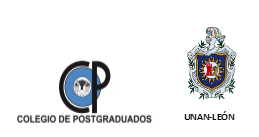Capacidad reproductiva de Nannochloropsis oculata en diferentes concentraciones de salinidad y fertilizante: un enfoque de la bioeconomía acuícola
DOI:
https://doi.org/10.5377/ribcc.v6i12.9977Palabras clave:
Batería, Salinidad, Temperatura, Nannochloropsis, Nutriente, Bioeconomia AcuícolaResumen
El objetivo del presente estudio fue evaluar el ritmo reproductivo de Nannochloropsis oculata usando dos baterías experimentales y aplicando dosis únicas de 0.32 ‰ y 1 ‰ de F/2 Guillard, respectivamente; en salinidades de 33 ‰, 25 ‰, 20 ‰, 15 ‰, 10 ‰ y 5 ‰, periodos de 10 y 23 días y temperatura de 25 ºC. En un primer experimento, con 0.32 ‰ de F/2 Guillard, N. oculata presentó mayor número de cel/ml en salinidades de 33 ‰ y 25 ‰, a los 8 días de estudio, denotando la afinidad de N. oculata de reproducirse con mayor velocidad en ese rango de salinidad. La importancia del uso de F/2 Guillard fue observada usando 1‰ debido a que la microalga presenta similar número de cel/ml (P≤0.05) en concentraciones salinas de 33 ‰, 25 ‰, 20 ‰ y 15 ‰ y similar concentración a las microalgas cultivadas con 0.32 ‰ de F/2 Guillard en salinidades de 33 ‰ y 25 ‰. La capacidad de N. oculata de reproducirse en concentraciones salinas de 33 ‰, 25 ‰ y 20 ‰ y niveles bajos de nutrientes fue testado en un segundo experimento donde los resultados muestran similar número de cel/ml entre los tratamientos salinos, en ambas baterías, a los 23 días de cultivo. Nuestros resultados sugieren que N. oculata puede reproducirse con escaza concentración de nutrientes y que su metabolismo puede estar siendo mediado por la catálisis de algunas proteínas como rubisco que sirve como una importante reserva de nitrógeno, azufre y carbono.
Descargas
873
HTML 0
Publicado
Cómo citar
Número
Sección
Licencia
Copyright © Rev. iberoam. bioecon. cambio clim. (Colegio Postgraduados y UNAN-León, Escuela de ciencias agrarias y veterinarias/ Departamento de Agroecología/Centro de Investigación en Bioeconomía y Cambio Climático (CIByCC).








